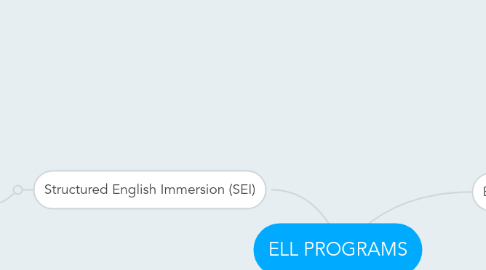
1. Structured English Immersion (SEI)
1.1. GOALS
1.1.1. The goal set forth in Arizona law is for ELLs to become fluent English proficient in a year.
1.1.1.1. Examples: Here's what an average day looks like for an ELL student at George Washington Elementary School: - Pronunciation and listening skills, 20 minutes. - Vocabulary, 30 minutes. - Verb tense instruction, 20 minutes. - Sentence structure, 20 minutes. - Integrated grammar skills application, 20 minutes. - English reading and writing, 60 minutes. - Math (specially designed academic instruction in English), 40 minutes. - Science, social science, P.E., 40 minutes.
2. Early Exit Transitional
2.1. GOALS
2.1.1. • Provide access to the state curriculum • Teach English to LEP students using appropriate researched-based methods; • Help build knowledge and learning of academic subjects in the first language and English • Instills self-assurance, confidence and cultural pride in students.
2.1.1.1. Examples The Transitional Bilingual Early Exit Program follows the program features as written by the Texas Education Agency (TEA) 1. Pre-literacy skills and reading will be taught in Spanish for students who are identified as LEP and dominant in Spanish; 2. Initial concept development for Spanish dominant LEP students will be in the primary language until the student reaches an English proficiency level of 4 or 5 as specified in the Oral Language Proficiency Tests ( Pre- LAS 2000, & LAS Links) and as documented in the ELL Student Language Acquisition Profile form; 3. Spanish language instruction for the Spanish dominant students will continue as long as the students remain in the Transitional Bilingual Early Exit Program and until criteria is met to transfer them into English. This will be achieved by providing high levels of language development in the primary language and in English as a Second Language and documented in the ESL Student Language Acquisition Profile form; 4. The program maintains strict separation of the language of instruction throughout specified content area blocks; 5. ESL instruction MUST occur daily. English instruction gradually increases as the students’ proficiency in English develops; 6. Daily comprehensible content area instruction in English is taught using concepts and skills drawn from content already taught that in Spanish; 7. Content area instruction and the language of instruction for each content area are noted in the teacher’s lesson plan; 8. Assessment is administered in the primary language and/or the second language as specified by the Language Proficiency Assessment Committee (LPAC); 9. The classroom environment is language and content rich and reflects a bilingual setting. There is evidence of English and Spanish in the following: state adopted instructional materials, instructional bulletin boards, center labels, center materials and equipment, student products, posted classroom and school rules, and written communications to parents; and 10. Strong parental support and involvement are essential to reinforce children’s native and English language development and communicate high expectations about academic achievement.
